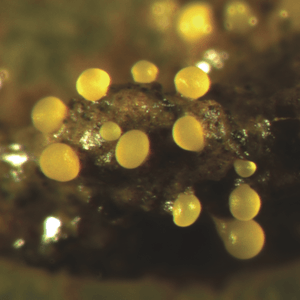Myxobacteria facts for kids
Quick facts for kids Myxobacteria |
|
|---|---|
 |
|
| Myxococcus xanthus | |
| Scientific classification | |
| Kingdom: | |
| Phylum: | |
| Class: |
Deltaproteobacteria
|
| Order: |
Myxococcales
|
Myxobacteria are tiny living things, also known as "slime bacteria." They are a special group of bacteria that usually live in the soil. They eat things that don't dissolve easily, like bits of dead plants or other tiny organisms. Myxobacteria have very large genomes, which are like their instruction manuals, compared to many other bacteria. They belong to a big group of bacteria called proteobacteria.
These bacteria move by gliding along surfaces. They often travel in groups called swarms. In these swarms, many cells stick together using special chemical signals. The swarm works together to release chemicals called enzymes. These enzymes help them break down and digest their food more easily.
Life Cycle of Myxobacteria
When there isn't enough food, myxobacteria cells gather together. They form special structures called fruiting bodies. These fruiting bodies can be many different shapes and colors, depending on the type of myxobacteria.
Inside these fruiting bodies, the cells change into round, tough structures called myxospores. These myxospores have thick walls that protect them. Just like spores in plants or fungi, myxospores can survive until there is more food available. When food returns, the myxospores open up, and new myxobacteria start to grow. They form a new swarm, ready to find food again. This life cycle is a bit like what happens with some amoebae called cellular slime moulds.
What Myxobacteria Can Do
Myxobacteria are very useful because they make many different chemicals. Some of these chemicals are antibiotics, which can fight off harmful bacteria. These chemicals are released outside the myxobacteria cells.
Scientists also study some types of myxobacteria as model organisms. This means they are used to learn about how living things grow and develop. For example, researchers study how myxobacteria decide to form their fruiting bodies.
See also
 In Spanish: Mixobacterias para niños
In Spanish: Mixobacterias para niños

